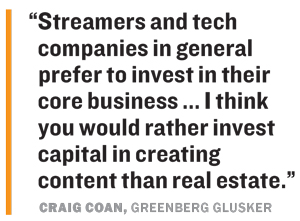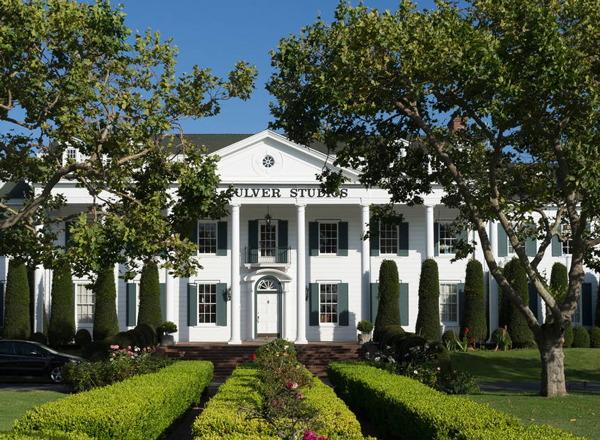The streaming wars’ latest skirmish came in October when Apple announced it would produce the World War II series “Masters of the Air” in-house at the company’s Apple TV+ studio in Culver City.
Hollywood saw the news as proof that Apple is joining Netflix and Amazon Studios as streaming’s biggest threats to film studios, and that it would be foolish to bet against Apple, what with its $1 trillion-plus valuation.
“Apple is ready for takeoff,” the Hollywood Reporter gushed.
But Apple TV+ is also the most acute example of an issue affecting streaming giants, and perhaps the future of Los Angeles’ world-famous entertainment business: a lack of space.
Developers — most prominently Hackman Capital, Hudson Pacific Properties and Lincoln Property Company — have delivered on massive tenant improvements in order to get Netflix, Amazon and Apple to lease their L.A. buildings, transforming the city’s office market.
“We have the benefit of being the clear No. 1 entertainment capital of the world, and that’s not going to change,” said Michael Hackman, founder and CEO of Hackman Capital, which fully leased its Culver Studios to Amazon and paid $750 million for the 25-acre CBS Television City campus in December.
Despite a flurry of blockbuster lease deals, the A-list streamers still have far less space to make content in the city compared to the old-line studios they increasingly compete against. Even though developers are scrambling to repurpose space to accommodate them, their sheer appetites will likely lead them to look outside L.A. for the real estate they need. And there’s little room to grow. L.A. County soundstage space is at 92 percent capacity, according to Film LA.
 “When it comes to property,” said Michael Soto, a researcher at Transwestern, “the legacy studios basically have a 100-year head start.”
“When it comes to property,” said Michael Soto, a researcher at Transwestern, “the legacy studios basically have a 100-year head start.”
Streamers jet into LA
Once upon a time, the Los Gatos, California-headquartered Netflix had a friendly relationship with the major studio players, such as Disney, Warner Bros., Universal, Sony, Paramount and recent Disney acquisition Fox.
That started to shift in 2013 when Netflix premiered its much-acclaimed original series “House of Cards.”
Netflix “realized that if they owned original content and their own distribution path via streaming, they can achieve greater independence and competitiveness,” said Gene Del Vecchio, a marketing professor at the USC Marshall School of Business. Also, original programming meant decreased reliance on licensing content made by studios, Del Vecchio said.
But to make its own content, Netflix needed space close to actors, directors and screenwriters, not to mention grips, sound engineers and costume designers.
In other words, Netflix had to get serious about L.A.
In 2017, the company dispensed with its modest satellite office in Beverly Hills and moved into Hollywood, renting out 418,000 square feet of studio space at the Sunset Bronson lot from Hudson Pacific Properties. A year later, Netflix extended its lease at Sunset Bronson until 2031. The company simultaneously rented out Epic, a 13-story, 328,000-square-foot building across the street from Sunset Bronson, another lease that runs through 2031, and another parcel owned by Hudson Pacific.
Netflix wasn’t done. Last November, it executed a 12-year lease with Kilroy Realty Corporation for 355,000 square feet of space on Vine Street in Hollywood. It then leased a further 170,000 square feet, including Hollywood studio real estate owned by Lincoln Property Company.
When the dust had settled, Netflix had leased approximately 1.6 million square feet of Hollywood space. (The company also added to their space by setting up a 60,000-square-foot studio in Burbank this October.) Meanwhile, Amazon and Apple were similarly reshaping Culver City.
Last year, in a bid to ramp up its Prime video originals, Amazon moved production centers from Santa Monica to the fabled Culver Studios, filming site of both “Citizen Kane” and “Gone with the Wind.”
Hackman Capital leased the property to Amazon, and the Westside L.A. developer is expanding the studio to 721,000 square feet, an undertaking mostly financed by $620 million in Deutsche Bank loans.
“I sincerely believe their real estate acumen because everything they did on the warehouse side really proved to be ahead of the curve,” Hackman said of Amazon. “They figured out very quickly that they had to have their own studio lot, and when they know what they want, they make it happen.”
 Lincoln Property Company, meanwhile, announced in March 2018 it had leased 128,000 square feet of studio and office space in Culver City to Cupertino, California-headquartered Apple’s new streaming service.
Lincoln Property Company, meanwhile, announced in March 2018 it had leased 128,000 square feet of studio and office space in Culver City to Cupertino, California-headquartered Apple’s new streaming service.
The streamers’ moves helped spur a “building boom in Culver City,” said Kevin Klowden, executive director at the Milken Institute, a Santa Monica-based economics think tank.
“Streamers have joined — and even dominate — the studio leasing market,” said JLL’s Carl Muhlstein.
Space race
But the soundstages and office spaces leased by Netflix, Amazon and Apple don’t compare to what the studios own.
Take Paramount.
Show business observers knock the 107-year-old, Hollywood-based company for routinely placing last among studios in worldwide box office revenue and lagging in production. Paramount is scheduled to release 13 movies by the end of 2019, while Netflix is set to produce 90 films.
When it comes to land, though, the tables are turned.
The Paramount lot will reach 4.1 million square feet once a $700 million, 1.4 million-square-foot expansion is completed.
The story of Paramount v. Netflix in Hollywood is similar to the dynamic in Culver City.
A 20-minute walk from the Apple TV+ studio along Washington Boulevard leads to the 2 million-square-foot Sony Pictures lot, also dating from 107 years ago. The other, even bigger studios — Disney, Warner Bros. and Universal — own millions of square feet in office and soundstage space across Burbank and Studio City.
Disney also has the Santa Monica soundstage space used by Hulu, of which it has full control following a deal with Comcast.
Disney, Warner, and Universal are all set to start their own streaming platforms within the year.
Is the space disparity of great concern for streamers? Maybe not, since real estate since content providers lend and borrow real estate.

The grand front-porch
entrance to Culver Studios.
“You see Paramount trucks on the Disney lot, and Disney trucks on the Paramount lot,” Muhlstein said, a practice that the studios may extend by leasing lot space to streamers.
But the land issue may also prompt streamers to have a wandering eye. “Netflix is making the majority of its films outside Los Angeles,” Klowden noted.
What streamers want
Streamers are not eager to discuss their real estate needs. Netflix declined comment, and messages left with Apple and Amazon were not returned.
Developers and real estate agents were also loath to talk, lest they break the militant NDAs signed with the companies. (As one agent put it: “On background, Amazon is a very private company.”)
Sources close to Netflix did disclose that personnel in Los Angeles, not Los Gatos, make its local real estate decisions. The L.A. team includes Matt Tevenan, the company’s vice president of real estate and workplace production, and Ty Warren, vice president of physical production.
General patterns can be pieced together, in terms of what Tevenan, Warren and other streamer decision-makers look for.
“Streamers and tech companies in general prefer to invest in their core business,” said Craig Coan, a real estate attorney at Greenberg Glusker. “L.A. real estate is very expensive to buy, and I think you would rather invest capital in creating content than real estate.”
Streamers, though, are unafraid to throw money toward tenant improvements.
“Because of the volume of activity they have to create for a global audience, it doesn’t work with the traditional ‘network’ schedule … of hey, I have a show, I’ve got a pilot, I’m going to see how it goes, then I’m going to run it for a certain amount of months per year and do a year-to-year deal,” said Bill Humphrey of Hudson Pacific, the point person for Netflix’s lease at the Sunset Bronson studio.
“They are able to lease a number of stages and associated production office space, knowing that they are going to have a continuation of the content going on in those spaces and facilities on an ongoing basis for many years,” he added.
The investment could be for soundstages — which require high ceilings, specific acoustics and lots and lots of parking. Money could also go toward designing office spaces replete with the sofas and Ping-Pong tables tech companies are known for.
Humphrey believes that his firm has an edge, given its concentration of Hollywood properties. “Creative people I talk to say Hollywood is central, because you’ve got studios and the lot production in the Valley — in Burbank especially. You’ve got Paramount down the street and you’ve got Fox and Sony toward Culver City.”
Also toward Culver City is the Amazon-occupied Culver Studios, which Hackman Capital purchased for $85 million in 2014 with an eye toward the streamers and their increasing demand for space.
Hackman said the streamers have “unique and very specific” requirements, including 40- to 50-foot ceiling height, wardrobe space, room to build set designs, and other physical compartments.
Such environments can triple rents, Coan said.
It also means lease agreements of 12 to 14 years. That’s double the typical lease agreements for soundstage space.
“These leases are longer than usual, probably because of the magnitude of the improvements,” Coan said.
While the streamers take great care with their leases, where they lease is less important.
Why Hollywood and Culver City emerged as streaming hubs is “simply because of availability,” Coan said.
“Culver City is generally going through a process of redevelopment,” said Matthew Ball, the former head of strategy at Amazon Studios and now a venture capitalist in the media space. “It is less hyperdeveloped than Santa Monica or Venice.”
What the future holds
Entertainment and real estate market experts alike portrayed Netflix, Amazon, and Apple as consummate real estate pragmatists, companies that are not animated by any grand vision or belief in the primacy of a particular locale.
“Studio space demand has escalated, but I don’t think there is a drastically different change in where shows are made,” said Ball.
The former Amazon executive gave the example of a show that’s made in New York state one year, learns its soundstage is to be occupied by another show and then sets up shop in Vancouver for the next year.
L.A. figures into the streamers’ equation as the most important market, Klowden said, but also one with drawbacks.
Lack of space is the biggest disadvantage, but L.A. also has more expensive labor and less generous tax credits than states including Georgia and New Mexico.
The same October 2018 week that Netflix announced its Epic building lease, the company said it would accept $14.5 million in state and local tax credits to build a production space in Albuquerque.
Netflix also announced plans for 260,000 square feet of office and soundstage space in New York City this April.
The streamers’ flexibility about location leaves developers unsure how much more to build, though they are moving ahead full steam on a few projects.
Last August, in partnership with New York investment firm Square Mile Capital Management, Hackman Capital purchased the $650 million Manhattan Beach Studios, which can be used for content creation.
And buoyed by its lease deals with Apple and Netflix, Lincoln Property announced construction of 320,000- and 150,000-square-foot buildings in Culver City, which the developer plans to lease out to entertainment and tech companies.
Developers could get creative in finding more space. “Abandoned shopping centers are arguably a resource,” Coan said. “You could convert an old Sears into a soundstage.”
Other L.A. neighborhoods, like Atwater Village and El Segundo, and perhaps Netflix’s Burbank move indicate a foray into the valley. The question is what developers can move quickly enough to satisfy streamers’ ravenous but specific real estate appetite. “These streamers,” Coan said, “are looking for space everywhere.”

